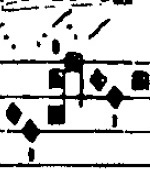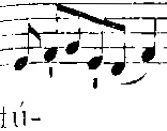Solesmes Salicus Again - HELP NEEDED!
-
In the Solesmes rhythmic edition, a salicus is sometimes indicated by a vertical episema placed over the podatus, in which case the sign "indicates a rather important ictus which should be brought out in the rendering" (Rules for Interpretation). A podatus with a vertical episema above it followed by a virga doesn't always indicate a salicus however. One of my singers has asked how to distinguish one from the other without consulting another book and I'm stumped. In the offertory for the upcoming feast of St. Michael, we have the following, a true salicus:

Whereas in the gradual for the feast of the Holy Rosary, we find the same notation at the word justitiam signifying something else:
Is there some explanation? Why is there an episema or ictus mark at that spot in the latter? Similarly in the gradual Probasti at meum and the offertory Angelus at dixit. Obviously, whether or not the notation indicates a salicus can easily be determined with reference to the St. Gall neumes or even the modern notation edition of the Liber:
versus
But how on earth is one supposed to figure that out from the rhythmic edition alone??
 Stetit Angelus.jpg140 x 244 - 11K
Stetit Angelus.jpg140 x 244 - 11K
 Propter veritatem.jpg150 x 169 - 11K
Propter veritatem.jpg150 x 169 - 11K
 Stetit Angelus MN.jpg167 x 131 - 9K
Stetit Angelus MN.jpg167 x 131 - 9K
 Propter veritatem MN.jpg181 x 92 - 10KThanked by 1Incardination
Propter veritatem MN.jpg181 x 92 - 10KThanked by 1Incardination -
I think - and it is just a suggestion - that the reason for the epizema in the second example is that it was added by Mocquereau for counting purposes, as differentiated from an epizema that might have occurred from the original notation, i.e. a true salicus. In the second example, Mocquereau would have been indicating (from the 1st ictus) 1-2 1-2-3 1-2... without marking it, the likely count would have been 1-2-3 1-2 1-2.
At least, that's according to how I was taught to count back in the dark ages.
Whether true or not as a reason for the ictus in the 2nd case, I don't think you can differentiate the two without reference to another book... but perhaps someone else has more information.
Thanks for posting the question - I'm curious to read other responses.Thanked by 1madorganist -
In the Solesmes rhythmic editions, the salicus is indicated by a vertical episema under the *podatus* except where there is an interval of a fifth. The editors of the Solesmes editions (Dom Mocquereau et al.), lacking the Graduale Triplex, relied on a collection of old manuscripts from the 9th-12th centuries. So there may be some differences in interpretation regarding the notation.
Note that Robert Carroll addresses your question in his book on Gregorian Chant which may be found on musicasacra.com. -
With due respect, this is only partially correct. An erroneous interpretation persists that when the vertical episema appears over the podatus of the salicus, the marked note is lengthened only if the interval is a fifth. I recently discussed this point in another thread. Please refer to the English introduction to the Liber, section IV.6 of the Rules for Interpretation. The neume at the beginning of the "Gaudeamus" introits and elsewhere is not a true salicus, but rather a scandicus with a neumatic break. Carroll describes it as a neume similar to the salicus, and gives examples with a podatus of a fourth as well (pp. 65-9 of his Applied Course). Do you have a page reference that addresses my specific question? I would truly appreciate it. I have read the book cover to cover but don't recall a discussion of it.In the Solesmes rhythmic editions, the salicus is indicated by a vertical episema under the *podatus* except where there is an interval of a fifth. -
This might not seem helpful, but I'd suggest ignoring the salicus altogether (and probably 40% of the vertical episema). I was never originally taught to hold that second note and simply treated it as a note with an ictus (or didn't even do that if I felt placing it on another note would sound better). No regrets. Holding that second note often makes the chant drag. -
Understood, but the question is specifically about the old Solesmes interpretation and notation, historically inaccurate though it be. I'm stumped by the question of one of my schola members. Easy enough for me to check the Triplex, but my men don't have those at their disposal.
-
Gotcha.
-
So you’re asking how to infer the interpretation of a resource they do not have from a differing interpretation in a different resource?
Pencils. -
More to the point, I'm asking if I'm missing some nuance in the notation of the rhythmic edition.
-
On p. 7 of Gregorian Musical Values (Desrocquettes),
(Not Carroll as I mistakenly indicated above.)We treat as a salicus [1] every ascending group of 3 or more notes of which the penultimate ascending note is marked underneath by the vertical episema.
If the vertical episema, in an ascending group, is printed above the note, we do not treat the group as a salicus [2] except in the case of an interval of a fifth.
[1] We say "treat as a salicus": we know that sometimes in the MSS it is not, in fact, a salicus; but having to deal with an imperfect edition, we are obliged to adopt a practical rule which corresponds to the majority of the cases.
[2] As a matter of fact it sometimes is a salicus in the MSS. We have adopted here the treatment which more often corresponds to the MSS.
-
Thanks for this reference! Gajard says something very similar on p. 45 of The Rhythm of Plainsong, mentioning that his guidelines for which neumes to treat as a salicus are practical rather than scientific. It does seem to contradict what's in the intro to the Liber and also the modern-notation edition. I checked the accompaniment editions of Potiron and Bragers and see that they are in agreement with the modern-notation Liber. In the offertory I mentioned above, there are three examples of the salicus with the vertical episema over the podatus. Potiron transcribes all three with a horizontal episema over the marked note. He and Bragers do the same in the graduals for the 4th, 9th, and 23rd Sundays after Pentecost, where similar instances occur just before the verse. (I don't have the Bragers sanctoral accompaniment and don't know whether such exists). Would it be more reasonable to suppose that Bragers and Potiron simply referred to the modern notation Liber when there was an ambiguity, or that they referred to the manuscripts, or that they were aware of some principle we haven't yet managed to uncover?
Welcome to the MusicaSacra Forum!
To participate in the discussions on Catholic church music, sign in or register as a forum member, The forum is a project of the Church Music Association of America.
Categories
- All Discussions21,055
- General Music Discussion8,194
- Job Openings190
- Management of Music Programs850
- Choral Matters532
- Church Documents and Rubrics524
- CMAA Notes300
- Events713
- For Newcomers: Read First26
- Sacred Polyphony546
- Hymnody871
- Gregorian Chant: General2,694
- ↳ Graduale Romanum and Liber Usualis367
- ↳ Graduale Simplex60
- ↳ Semiology63
- Vernacular Plainsong695
- Anglican Use and Anglican Chant69
- Organ, Other Instruments and Repertoire433
- New Composition/Works in Progress1,286
- Recordings229
- Music for Hispanic Ministry159
- Music Education: Children211
- Music Education: General222
- News Items245
- Positions Wanted2
- General Discussion: Catholicism738
- Amusements176
- General Discussion1,033
- Opinions117

